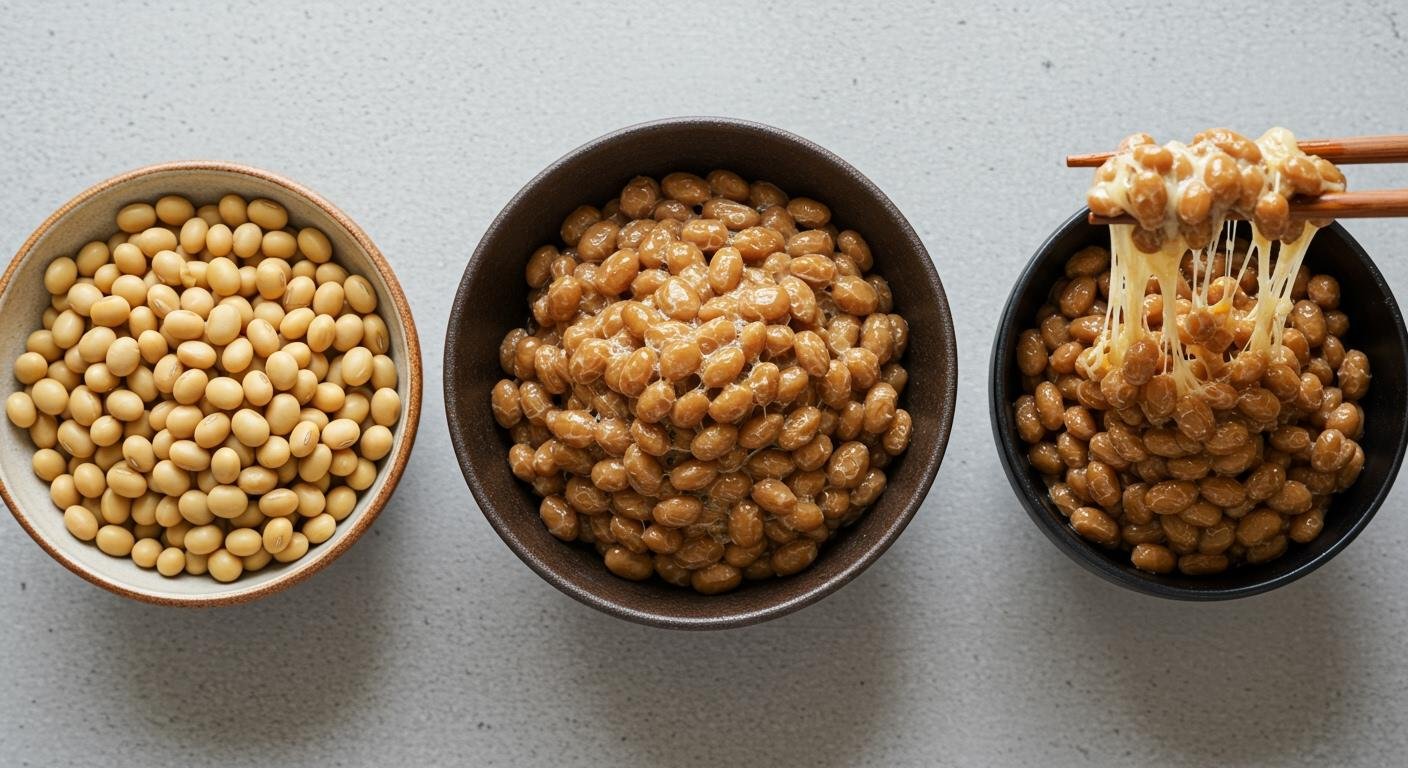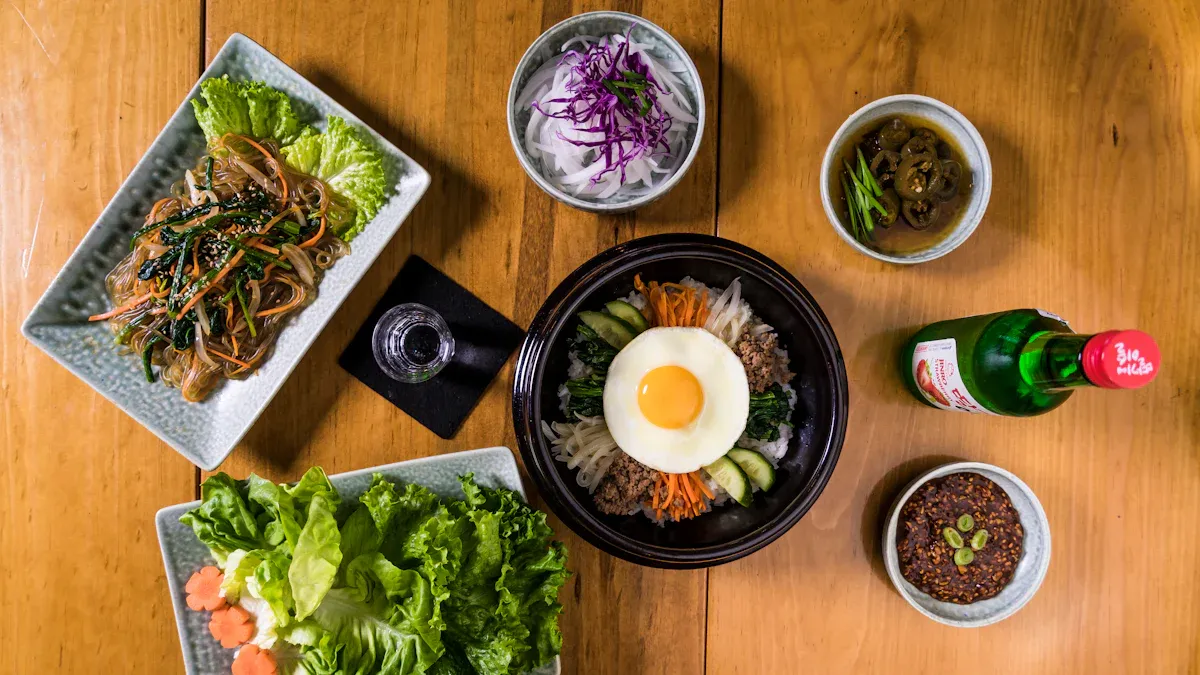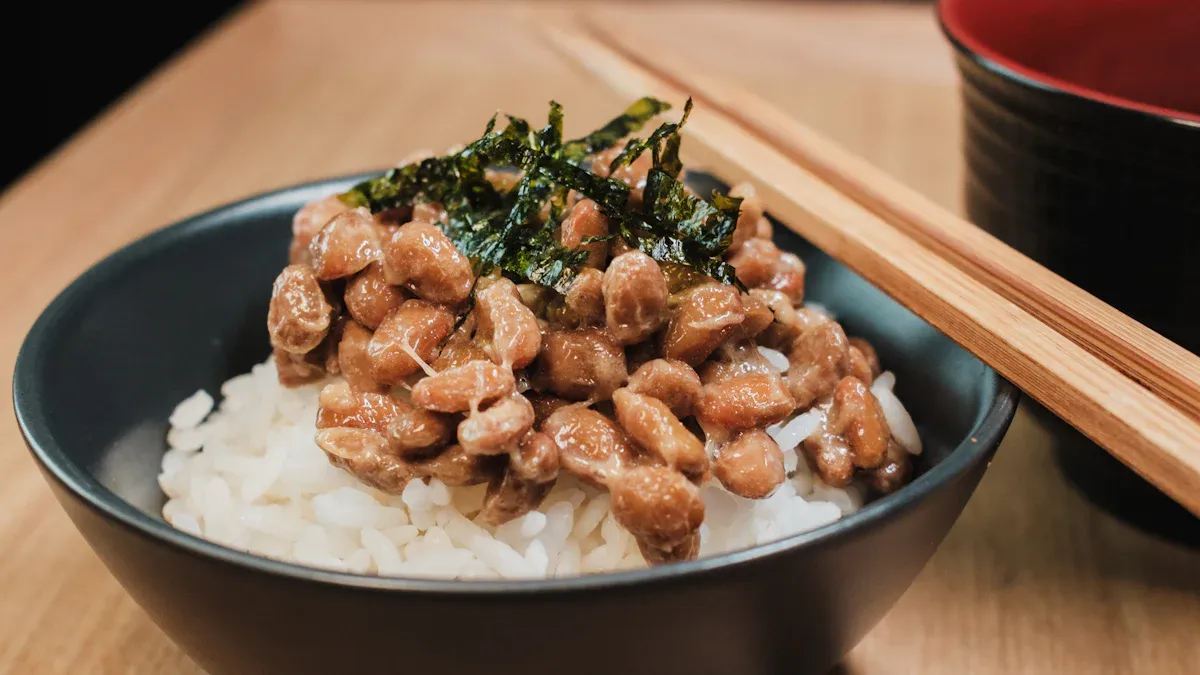How Soybeans Become Natto A Simple Guide
Table of Contents

Natto is a traditional Japanese food made from fermented soybeans. A specific bacterium, Bacillus subtilis var. natto, begins the transformation. In Japan, people enjoy roughly 7.5 billion packets of this unique natto each year. The popular food is also a nutritional powerhouse.
“It’s considered the richest source of vitamin K2,” says Jon Lanman, RD, a registered dietitian.
Understanding how soybeans become natto reveals a fascinating culinary science. This simple journey creates the unique texture and deep flavor of the finished natto.
THE ESSENTIAL INGREDIENTS

The creation of authentic natto relies on two simple yet crucial components. These ingredients work together in a precise process to produce the final food.
- Soybeans
- Natto bacteria (
Bacillus subtilis)
Each element plays a vital role. The quality of the soybeans and the purity of the bacteria directly impact the final taste and texture of the natto.
SELECTING THE SOYBEANS
Producers do not use just any soybean to make natto. The ideal beans are quite small, often less than 5.8 millimeters in diameter. This smaller size allows the fermentation to reach the center of each bean more easily. A thin seed coat also helps this process. The most popular soybeans for natto create a product that is easy to eat and pairs well with rice.
Different soybean sizes produce distinct types of natto. This variety allows for different textures and eating experiences.
Producers often choose from specific categories:
- Extra Small Natto: These tiny soybeans are highly valued for their delicate texture.
- Small Natto: This common size provides an excellent texture for classic natto.
- Natto Grits: Makers quarter normal-sized soybeans to create this option, offering a familiar bean texture.
INTRODUCING NATTO BACILLUS
The magic of natto comes from a special bacterium. Its scientific name is Bacillus subtilis var. natto. This microbe is a unique variant of the common Bacillus subtilis bacterium. It is a rod-shaped organism found naturally in the Japanese environment, especially in places where natto has been made for centuries.
Scientific studies show what makes this bacterium special. DNA analysis confirms its unique genetic structure. A key difference is its need for biotin, a type of B vitamin, to grow well. The standard Bacillus subtilis does not have this requirement. This specific need ensures that only the correct bacteria thrive during fermentation, which is essential for making safe and delicious natto.
THE PROCESS OF MAKING NATTO

The journey from a simple soybean to the complex food of natto is a precise, multi-step process. Each stage builds upon the last, creating the conditions for a perfect transformation. Understanding how natto is produced reveals a careful balance of time, temperature, and microbiology.
STEP 1: WASHING AND SOAKING
The process begins with clean, high-quality soybeans. Producers first wash the beans thoroughly to remove any dirt or debris. After washing, the beans go into a long soak. They rest in water for 12 to 24 hours. During this time, the soybeans absorb water and expand significantly, often doubling in size.
This extended soaking period is crucial. It softens the tough outer seed coat, which prepares the beans for even cooking. Soaking also improves the nutritional quality of the final natto.
Research shows that a 12-hour soak can increase total proteins by 17% and reduce phytic acid by 50%. This process makes the nutrients inside the soybeans more available to the body. It also reduces other unwanted compounds like tannins, improving the bean’s digestibility.
STEP 2: STEAMING THE BEANS
Once soaked, the soybeans are ready for cooking. Steaming is the best method for preparing beans for natto. Producers often use a pressure cooker, which cooks the beans perfectly in about 40 to 45 minutes. The goal is to make the soybeans incredibly soft. A properly cooked bean should be easily squished into a paste between the thumb and pinky finger.
Boiling is not a suitable method for this step. It can cause several problems:
- The beans can become too wet, leading to a waxy texture.
- The final product may lack flavor and stringiness.
- The skins of the soybeans can detach during the boil.
Pressure steaming keeps the beans from becoming waterlogged. It also retains the natural flavors that the Bacillus subtilis bacteria need as food. This careful cooking step ensures the beans have the ideal light beige color and soft consistency for fermentation.
STEP 3: INOCULATION
Inoculation is the step where the magic happens. Here, producers introduce the Bacillus subtilis var. natto culture to the cooked soybeans. This step must happen while the beans are still hot, typically around 40°C (104°F). Adding the culture at this high temperature is a critical safety measure. It prevents other unwanted bacteria from growing and ensures the natto bacteria can thrive without competition.
The amount of starter culture needed is very small. A tiny pinch of powder, often just 0.1 grams, is enough for a large batch of over two cups of soybeans. The powder is usually mixed with a small amount of sterile water and then stirred evenly into the hot beans. This ensures every bean gets coated, setting the stage for a successful fermentation. This is a key part of making natto.
STEP 4: FERMENTATION
Fermentation is the final and most transformative stage. The inoculated soybeans are placed in sealed, shallow containers and kept in a warm, humid environment. The ideal conditions for natto fermentation are a consistent temperature of about 40°C (104°F) and high humidity. The beans will ferment for 14 to 24 hours.
During this time, the Bacillus subtilis bacteria multiply rapidly. They consume the nutrients in the soybeans and produce a range of enzymes, including proteases, that trigger incredible changes.
- Nutrient Breakdown: The bacteria break down the soybean’s complex proteins, fats, and carbohydrates into simpler forms. This makes the finished natto easier to digest.
- Flavor Development: Key amino acids are created, which build the deep umami flavor unique to natto.
- Texture Creation: The bacteria produce a sticky, stringy biofilm made of polyglutamic acid that covers the beans. After about 24 hours, this results in the luscious, stringy texture natto is famous for.
- Health Boost: The bacteria convert compounds called isoflavones into a form that is more bioavailable, meaning the body can absorb them more easily.
This controlled process is the heart of making natto, turning soft soybeans into a nutrient-dense food with a distinct aroma and texture.
HOW SOYBEANS BECOME NATTO: THE FINAL STAGES
The transformation from fermented beans to ready-to-eat natto requires two final, crucial stages. These steps stabilize the product, develop its signature flavor, and prepare it for enjoyment. This is how the soybeans become natto in its final form.
STEP 5: COOLING AND MATURATION
After fermentation, the natto undergoes a two-part finishing process. This ensures the best flavor and texture.
- Cooling: Producers first move the containers of warm natto to a cool environment. This rapid cooling stops the fermentation process. It also helps develop the characteristic stringiness of the final natto.
- Maturation: The cooled natto is then aged in a refrigerator. It rests at a low temperature, around 5°C (41°F), for at least 6-8 hours and up to one week. This maturation period allows the flavors to settle and deepen, creating a mellow, rich umami taste.
THE FINISHED PRODUCT
Once maturation is complete, the product is officially finished. The beans are now covered in a sticky, web-like substance. This gooey coating is a key indicator of a successful fermentation. Producers then package the natto, often in styrofoam containers, and add a label. The finished natto is now ready for shipment to stores. The journey of how soybeans become natto is complete.
FLAVOR AND TEXTURE
The final natto has a unique sensory profile. Its most famous feature is its sticky, stringy texture.
- Stirring the natto creates an extremely stringy consistency known as
neba-neba. - These gossamer threads stretch between the beans and your chopsticks.
- This stringiness is a mark of high-quality natto and vigorous fermentation.
The bacteria produce a compound called polyglutamic acid during fermentation. This polymer creates the deep umami flavor and the signature stickiness of the natto. The beans themselves are soft but retain a pleasant firmness, all surrounded by a slippery mouthfeel.
The journey of how soybeans become natto involves five key stages: soaking, steaming, inoculating, fermenting, and maturing. This controlled fermentation creates natto’s famous stringy texture and deep umami flavor. The process also makes natto a powerhouse for supporting gut health and the immune system. Now that you know how soybeans become natto, you can explore its unique taste.
Try this food the traditional way! 🍚 Mix natto with steamed rice and a bit of spicy karashi mustard for an authentic experience.
FAQ
What does natto taste like?
Natto possesses a strong, earthy flavor. It has deep umami notes, similar to aged cheese. The beans themselves have a nutty quality. The overall taste is complex and savory.
Why is natto so stringy and sticky?
The Bacillus subtilis bacteria create a sticky biofilm during fermentation. This substance is polyglutamic acid. It produces the famous stringy texture.
This stringiness, known as
neba-nebain Japanese, is a sign of high-quality natto! 🥢
Can people make natto at home?
Yes, home cooks can make natto. The process requires soybeans and a natto starter culture. A warm, stable environment is also necessary for fermentation. Many people use yogurt makers or proofing boxes.
Is natto a healthy food?
Natto is a very healthy food. It provides high amounts of protein and fiber. The food is also an excellent source of vitamin K2. This vitamin supports bone and heart health.

Poseidon
Master of Nutritional Epidemiology, University of Copenhagen, Herbal Functional Nutrition Researcher
Focus: The scientific application of natural active ingredients such as Tongo Ali, Horny Goat Weed, and Maca to sexual health and metabolic regulation.
Core Focus:
Men: Use a combination of Tongo Ali (an energizing factor) + Maca (an energy reserve) to improve low energy and fluctuating libido.
Women: Use a combination of Horny Goat Weed (a gentle regulator) + Maca (a nutritional synergist) to alleviate low libido and hormonal imbalances.
Stressed/Middle-Aged Adults: This triple-ingredient synergy supports metabolism, physical strength, and intimacy.
Product Concept:
Based on traditional applications and modern research (e.g., Tongo Ali promotes testosterone-enhancing enzyme activity, and icariin provides gentle regulation), we preserve core active ingredients and eschew conceptual packaging—using natural ingredients to address specific needs.
Simply put: I'm a nutritionist who understands "herbal actives." I use scientifically proven ingredients like Tongo Ali, Epimedium, and Maca to help you make "sexual health" and "nutritional support" a daily routine.
